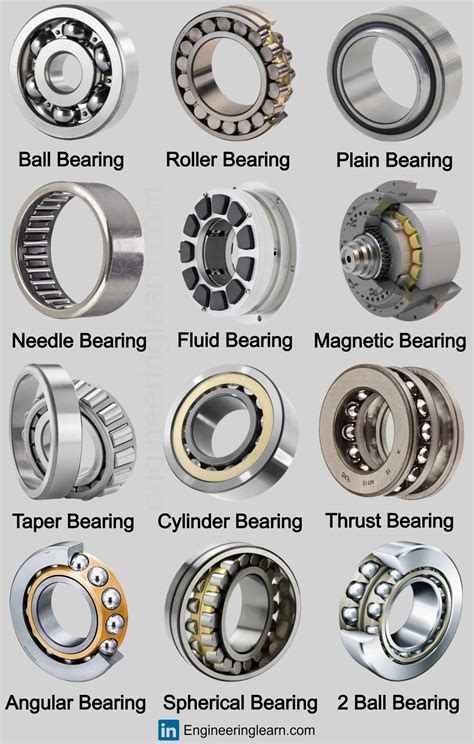Bearings: The Invisible Workhorses of Modern Machinery
Introduction
Bearings play a pivotal role in the smooth functioning of countless machines and devices. They reduce friction, minimize wear and tear, and ensure efficient power transmission. This comprehensive guide delves into the vast world of applied bearings, exploring their types, benefits, and effective implementation strategies.
Types of Applied Bearings
1. Plain Bearings

Plain bearings, also known as journal bearings, consist of two surfaces sliding against each other. They are simple to manufacture and economical but have limited load capacity and speed tolerance.
2. Rolling Bearings
Rolling bearings utilize balls, rollers, or needles to reduce friction and enable higher loads and speeds. They are categorized into:

- Ball bearings: Versatile and widely used in various industries.
- Roller bearings: Designed to handle heavy loads and minimize friction in demanding applications.
- Needle bearings: Compact and suitable for applications with space constraints.
3. Special Bearings
Special bearings are designed for specific requirements, such as:

- Fluid bearings: Utilize a fluid film to separate the sliding surfaces, virtually eliminating friction.
- Magnetic bearings: Use magnetic forces to suspend a shaft, achieving very high speeds and precision.
Benefits of Applied Bearings**
-
Reduced Friction: Bearings minimize friction between moving parts, improving efficiency and reducing energy consumption.
-
Enhanced Durability: They prevent premature wear and tear, extending the lifespan of machinery.
-
Increased Load Capacity: Bearings can withstand significant loads, enabling machines to operate under demanding conditions.
-
Improved Speed: Rolling bearings facilitate higher speeds compared to plain bearings, enhancing productivity and efficiency.
-
Compact Design: Some bearing types, such as needle bearings, offer compact solutions for space-constrained applications.
Choosing the Right Bearing for Your Application
Selecting the appropriate bearing for an application requires careful consideration of:
-
Load Requirements: The bearing must be capable of supporting the expected loads without failure.
-
Speed: The bearing should be rated for the operating speed of the machinery.
-
Environment: The bearing must be resistant to the operating conditions, such as temperature, humidity, and chemical exposure.
-
Size and Weight: The bearing's dimensions and weight must be suitable for the available space and weight constraints.
-
Cost: The bearing's cost should be balanced against its performance and longevity.
Effective Strategies for Bearing Implementation
-
Proper Lubrication: Regular lubrication is crucial for bearing longevity. Select the appropriate lubricant based on operating conditions and follow the manufacturer's recommendations.
-
Mounting and Installation: Bearings should be properly mounted and aligned to ensure optimal performance. Refer to the manufacturer's guidelines for precise installation instructions.
-
Maintenance and Inspection: Regularly inspect bearings for wear or damage. Implement a preventive maintenance schedule to identify and address issues before they become major problems.
Potential Drawbacks of Applied Bearings
Despite their many benefits, applied bearings may have certain drawbacks:
-
Cost: High-performance bearings can be expensive, especially for demanding applications.
-
Complexity: Some bearing types, such as fluid and magnetic bearings, require specialized installation and maintenance techniques.
-
Limited Lifespan: Bearings have a finite lifespan, which can vary depending on operating conditions and maintenance practices.
Inspiring Story: The Power of Applied Bearings
In a bustling factory, a malfunctioning bearing brought a critical production line to a halt. The engineers quickly identified the issue and replaced the worn-out bearing with a new one. The machinery roared back to life, resuming production at maximum efficiency. This incident highlighted the indispensable role of bearings in keeping the wheels of industry turning.
Tables: Data and Calculations
Table 1: Types of Bearings and Their Applications
| Bearing Type |
Applications |
| Plain Bearing |
Low-speed, low-load applications |
| Ball Bearing |
General-purpose, medium-load, medium-speed applications |
| Roller Bearing |
Heavy-load, high-speed applications |
| Needle Bearing |
Space-constrained, high-load applications |
| Fluid Bearing |
Very high-speed, low-friction applications |
| Magnetic Bearing |
Ultra-high-speed, precision applications |
Table 2: Bearing Failure Modes and Causes
| Failure Mode |
Causes |
| Wear |
Abrasion, contamination, improper lubrication |
| Fatigue |
Cyclic loading, excessive loads |
| Seizure |
Inadequate lubrication, overheating |
| Corrosion |
Exposure to corrosive substances, moisture |
| Misalignment |
Improper installation, foundation settlement |
Table 3: Bearing Lubrication Recommendations
| Bearing Type |
Lubricant Type |
| Plain Bearing |
Grease, oil |
| Ball Bearing |
Grease, oil, solid lubricants |
| Roller Bearing |
Grease, oil, solid lubricants |
| Needle Bearing |
Oil, solid lubricants |
| Fluid Bearing |
Fluid film |
| Magnetic Bearing |
No lubrication required |
Call to Action
Applied bearings are essential components for enhancing efficiency, durability, and overall performance of machinery. By understanding the different types, benefits, and implementation strategies, engineers and technicians can optimize bearing selection and maintenance practices. Embrace the power of bearings to unlock the full potential of your machines and keep them operating smoothly for years to come.
References:

American Bearing Manufacturers Association (ABMA)
